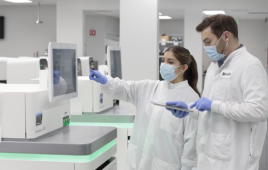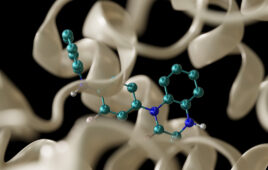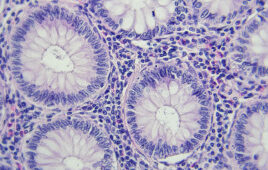
A Northwestern-led synthetic biology research team has combined technologies to develop a new biotech technique that promises to accelerate research into protein therapies that could one day become the next defense against antibiotic-resistant supergerms or the next new drug.
It began when Milan Mrksich, the Henry Wade Rogers professor of biomedical engineering, chemistry, and cell and molecular biology, and colleague Michael Jewett, the Charles Deering McCormick Professor of Teaching Excellence and associate professor of chemical and biological engineering, decided to compare notes and combine forces.
The pair, who lead Northwestern’s Center for Synthetic Biology, where Mrksich is the director and Jewett is the co-director, wondered what they could accomplish if they combined the Mrksich lab’s mass spectrometry technology with the Jewett lab’s expertise in glycosylation and rapidly making proteins.
Glycosylation, which is the attachment of sugars to proteins, plays a critical role in how proteins form and work in cells and how cells interact with other cells. It is also important in the study of disease and biotechnologies.
Their ideas began to crystallize when they looped in glycosylation engineering expertise of close collaborator Matt DeLisa, the William L. Lewis Professor of Engineering at the Robert Fredrick Smith School of Chemical and Biomolecular Engineering at Cornell University.
Together they developed a new platform for characterizing and optimizing sequences for making glycoproteins using cell-free protein synthesis and mass spectrometry.
The resulting advance is described in “Design of glycosylation sites by rapid synthesis and analysis of glycosyltransferases,” published on May 7 by the journal Nature Chemical Biology. Mrksich and Jewett are the co-corresponding authors. The two co-lead authors are Weston Kightlinger, a graduate student in Jewett’s lab, and Liang Lin, a Ph.D. student in Mrksich’s lab.
The new technique promises to vastly speed up the time needed to test compounds for potential new drugs. As recent as a few decades ago, drugs were based on natural products that were tediously isolated and characterized from plants and other natural sources
But once chemists learned to make libraries of large numbers of molecules – which today number in the millions – and once engineering brought laboratory automation forward as a tool, scientists and engineers were able to rapidly test millions of compounds within a few weeks to identify good starting points for drug development.
Still, Mrksich explained, in synthetic biology, the cycle time to test each enzyme-substrate interaction can take weeks or months.
“We have radically accelerated the process,” Mrksich said. “Where researchers today can evaluate a couple of hundred potential glycosylation tags in a given period, we’ve brought together two high-throughput technologies that allow us to evaluate several thousand in that same time frame.” These tags are important because glycosylation is present in 70 percent of protein therapeutics already approved or in preclinical evaluation.
The process works by combining three techniques from Northwestern laboratories:
- Cell-free protein synthesis, Jewett’s method of producing proteins without using living, intact organisms
- Protein glycosylation, a specialty of Jewett’s lab that allows researchers to rapidly create and test a large number of enzymes in test tubes
- SAMDI (self-assembled monolayers for matrix-assisted desorption/ionization) mass spectrometry from Mrksich’s lab, a super-fast, low-cost, and “label-free” method of measuring biochemical activities on a surface
Combined with the glycoengineering knowledge from DeLisa’s lab, the combined technique analyzes glycosylation quickly and effectively.
“We developed peptide arrays where we have one plate about the size of your hand that has approximately 1,500 circular regions on it,” Mrksich said. “Each of those regions has attached to it a different peptide tag, and we can apply the enzyme solution evenly across the full array and each of the peptide tags can then be glycosylated.”
After the plate is rinsed, the entire array can be analyzed by mass spectrometry, which quantifies the amount of glycosylation of each peptide.
“In a day, we can evaluate thousands of distinct peptide tags to identify the optimal ones for glycosylation that we then move forward with,” Mrksich said.
The result is not only much faster but also delivers much more detailed data. “Our method allows us to not just pick the winners, which we commonly look for in scientific experiments, but the failures too,” Jewett said.
The team dubbed the process GlycoSCORES, or glycosylation sequence characterization and optimization by rapid expression and screening.
DeLisa said he was excited to use the new technology to address a number of open questions regarding how different glycosylation enzymes work.
“This technique allows us to ask much more precise and scientific questions in this area than would have been previously possible,” he said. “The new knowledge that is derived could really be game-changing in terms of our ability to engineer glycoproteins with desirable traits.”
This work was supported by grants from the Defense Threat Reduction Agency and the National Science Foundation.
SOURCE: Northwestern University
Filed Under: Genomics/Proteomics



